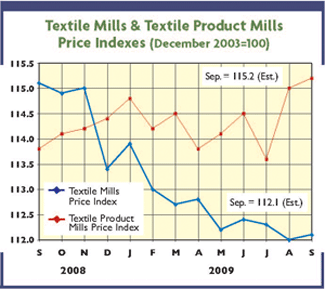E
vidence is mounting that things are finally beginning to bottom out after one of the
biggest declines in US textile/apparel history. For one, latest official government reports
indicate that the recently noted flattening-out in textile industry orders, production and
shipments is now about five months old. The Institute for Supply Management, a private group
measuring manufacturing activity at the grass roots level, tells pretty much the same upbeat story.
Equally important, all this is occurring at a time when the overall US economy is finally beginning
to show signs of recovery. Indeed, most economists and business analysts are now estimating that
gross domestic product — our broadest measure of business activity — will be growing at about a
2-percent annual rate over the last six months of the year. There are other signs, too, that the
worst of the current economic downturn is behind us. These include: some turnaround in business
spending for new plant and equipment; a slowly uptrending stock market; and the leveling-off in
profits reported by many industries during the second quarter — a sharp change from the
30-percent-or-so earnings decline noted over the first three months of the year. But probably the
most important things to emphasize are the following: The business recovery should have legs,
spilling over into early 2010 and beyond. Washington’s huge fiscal and monetary stimulus packages
would certainly seem to indicate as much. So would the fact that much of the impact from
infrastructure spending is only now beginning to work its way through the economy — with most of
the growth benefits not expected until next year.

A Look At Textile Earnings
Some further comments on profits may also be in order — namely, the overall improvement
noted above may soon spread to the textile area. And it will be coming none too soon. This year,
for example, the consensus is that mill profits could be off about 25 percent. Coming on top of the
decline in the previous three years, it means that mill earnings are probably down as much as 50
percent from levels prevailing in 2005. But things should be changing next year. Just-released
Global Insight projections provide some ideas as to just how much recovery to expect. Using its own
concept of future operating profits — basically shipments less both raw material and labor costs
— the consulting firm sees a slow 2010 turnaround. Looking first at basic textiles — yarns,
fabrics and such — the consulting firm’s analysts are expecting an earnings rise of about 8
percent to 9 percent — a big change from the large 16-percent and 28-percent declines of 2008 and
2009, respectively. The outlook for more highly fabricated textile products isn’t all that bad
either — with 2008 and 2009 slippages of 14 percent and 21 percent, respectively, expected to give
way to a small 4-percent increase by next year. A similar trend is seen for apparel, where the near
17-percent declines of both 2008 and 2009 shrink to only about a small 5-percent dip. Nor is the
longer-term profit prognosis for all these groups all that bad. Indeed, go into 2011 and 2012, and
the picture remains basically positive — with all three industry subgroups seen holding their own
as far as bottom-line performance is concerned.
The Cost Role In Profits
Much of the forecast mill profit turnaround, of course, can be attributed to expectations of
improving general business activity. But a fair amount also can be traced to the fact that both
mill labor and mill material costs should continue to be held in check. Again, the new Global
Insight numbers provide the details. Next year’s basic textile mill labor costs, for example, are
projected to decline by more than 10 percent. That’s far more than the 5-percent-or-so slippage in
basic mills’ expected shipment levels. And this same cost-shipment pattern is anticipated when it
comes to labor’s role in the output of more highly fabricated mill products. Bottom line: Even with
some forecast error, these numbers would seem to assure a modest drop in the textile industry’s
unit labor costs. And the picture isn’t all that different when looking at projected material costs
— with the two major textile subgroups showing a slightly bigger decline in material costs than in
shipments. What makes all the above particularly significant is the fact that these two inputs make
up the preponderance of mill production costs — accounting for more than three-fourths of shipment
value. Equally noteworthy, this ability to keep unit costs from advancing should continue into 2011
and 2012. If nothing else, all this would seem to assure a return to more profitable mill
operations — and, more importantly, survival in today’s hotly competitive one-world marketplace.
October 2009




